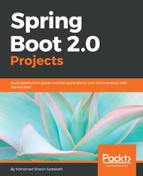Chapter 1, Introduction, outlines the Spring Boot 2.0 application development framework and compares its features with the previous version of Spring Boot. It also talks about configuration property changes, API changes, platform changes, and more in Spring Boot 2.0. Furthermore, it explains how to migrate from the previous version of Spring Boot application to Spring Boot 2.0 application.
Chapter 2, Building a Basic Web Application, begins with the practical side of developing a basic web application using the Spring Boot 2.0 Framework. It also talks about Spring Data JPA persistence, Spring Thymeleaf view, and Spring WebFlux controllers.
Chapter 3, Building a Simple Blog Management System, presents the practical side of developing a simple blog management system using the Spring Boot 2.0 framework. It also talks about Spring Data Elasticsearch for persistence, Apache FreeMarker view, and Spring WebFlux controllers.
Chapter 4, Introduction to Kotlin, introduces the programming language Kotlin by comparing it with Java programming language side by side. It will help to get started with Kotlin programming, subsequently moving into advanced topics in Kotlin such as OOP and other features.
Chapter 5, Building a Reactive Movie Rating API Using Kotlin, discusses reactive movie rating API development using Kotlin programming language with Spring Boot 2.0. It talks about Spring Data MongoDB persistence, Spring WebFlux controllers, and Spring Security authentication and authorization.
Chapter 6, Building an API with Reactive Microservices, explains reactive microservices development using Spring Boot 2.0. It also talks about Spring Data Redis persistence, Spring Web Flux controllers, Asynchronous data transfer among microservices, and Docker deployment of microservices.
Chapter 7, Building a Twitter Clone with Spring Boot, covers Angular application acting as a client for Spring Boot 2.0 REST API. It also talks about Spring Data JPA persistence, Angular 5 frontend, Spring Web Flux controllers, and Spring Security OAuth2 authentication and authorization.
Chapter 8, Introducing Spring Boot 2.0 Asynchronous, Quartz Scheduler introduces asynchronous application development using Spring Boot 2.0. It also talks about Apache Kafka as a message broker that enables decoupled, asynchronous communication between applications.
Chapter 9, Building an Asynchronous Email Formatter, explains details of how to build an Asynchronous Email Formatter, using Spring Boot 2 as the backend development framework and Apache Kafka as a message queue. It will also explain how to use JPA as the persistence layer, which is a widely used data source. It will use Apache FreeMarker to create the email templates and show how to use placeholders to provide dynamic data to email templates.
